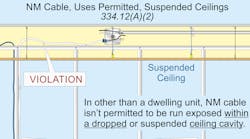Stumped by the Code? Requirements When Installing Type MC Cable
All questions and answers are based on the 2017 NEC.
Underline text indicates a Code change.
Q. What are the Code requirements when installing Type MC cable in accessible attics or roof spaces?
A. Type MC cable installed in accessible attics or roof spaces must comply with Sec. 320.23 [330.23].
On the surface of floor joists, rafters, or studs. In attics and roof spaces that are accessible, substantial guards must protect cables installed across the top of floor joists, or across the face of rafters or studding within 7 ft of the floor or floor joists. If this space isn’t accessible by permanent stairs or ladders, protection is required only within 6 ft of the nearest edge of the scuttle hole or attic entrance [Sec. 320.23(A)].
Along the side of framing members [320.23(B)]. When Type MC cable is installed on the side of rafters, studs, or floor joists, no protection is required if the cable is installed and supported so the nearest outside surface of the cable or raceway is at least 1¼ in. from the nearest edge of the framing member where nails or screws are likely to penetrate [Sec. 300.4(D)].
Q. What are the uses not permitted by the NEC for Type NM cable?
A. Types NM and NMC cables aren’t permitted [Sec. 334.12(A)]:
(1) In any dwelling or structure not specifically permitted in 334.10(1), (2), (3), and (5).
(2) Exposed within a dropped or suspended ceiling cavity in other than one‑ and two‑family, and multifamily dwellings (Figure).
(3) As service‑entrance cable.
(4) In commercial garages having hazardous locations, as defined in Sec. 511.3.
(5) In theaters and similar locations, except where permitted in 518.4(B).
(6) In motion picture studios.
(7) In storage battery rooms.
(8) In hoistways, or on elevators or escalators.
(9) Embedded in poured cement, concrete, or aggregate.
(10) In any hazardous location, except where permitted by other sections in the Code.
In addition, Type NM cables aren’t permitted to be used under the following conditions, or in the following locations [Sec. 334.12(B)]:
(1) If exposed to corrosive fumes or vapors.
(2) If embedded in masonry, concrete, adobe, fill, or plaster.
(3) In a shallow chase in masonry, concrete, or adobe and covered with plaster, adobe, or similar finish.
(4) In wet or damp locations.
Note: A raceway in a ground floor slab is considered a wet location.
Q. What are the Code requirements for Type MC cable to serve as an equipment grounding conductor (EGC)?
A. If Type MC cable is to serve as an EGC, then it must comply with Sec. 250.118(10) and Sec. 250.122 [330.108].
The outer sheath of traditional interlocked Type MC cable isn’t permitted to serve as an EGC; therefore, this cable must contain an EGC in accordance with Sec. 250.118(1) [250.118(10)a].
The outer sheath of interlocked Type MCAP cable containing an aluminum grounding/bonding conductor running just below the metal armor is listed to serve as an EGC [Sec. 250.118(10)(b)].
The outer sheath of smooth or corrugated-tube Type MC cable is listed to serve as an EGC [Sec. 250.118(10)(c)].





